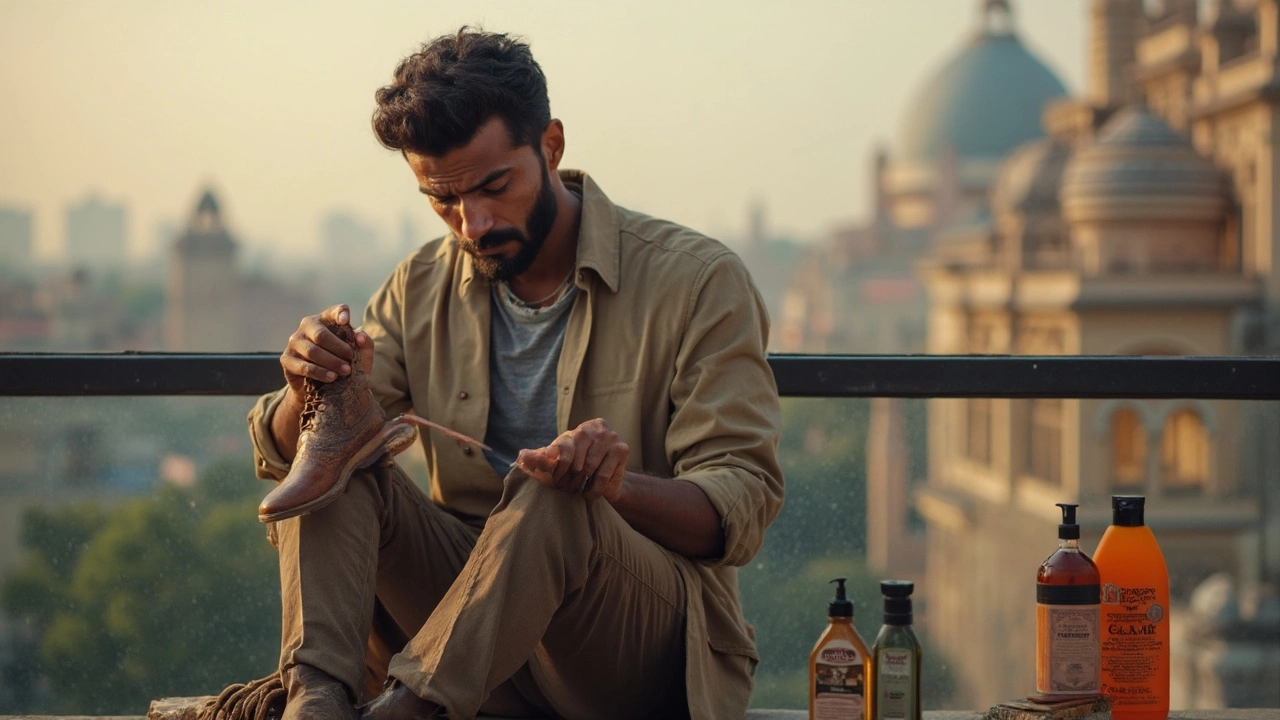Ever wiped a stain off your leather shoes with a damp towel and called it a day? Plenty of folks make that mistake, and it's one of those things that sneakily ruins good shoes over time. The truth is, leather is pickier than you think. Even the stuff you use around the house—Windex, vinegar, dish soap—can totally wreck the finish or dry the leather out until it cracks.
One buddy once tried cleaning his favorite oxfords with lemon-scented cleaner. He was after that fresh smell. Instead, his shoes turned blotchy, faded, and stiff as a board. It happens more often than you'd think. The urge to just grab whatever's under the kitchen sink is strong, especially after a late night out when a fresh spill looks like the end of the world. But trust me, those shortcuts backfire—and sometimes a shoe just won't bounce back.
Leather doesn't like to be soaked, scrubbed with anything gritty, or slathered with random oils. If you want your shoes to keep looking good season after season, you've got to know what to avoid. Stick around and let's save your favorite pair from becoming the before-picture in a repair shop ad.
- Household Cleaners: What Wrecks Leather Fast
- Water and Moisture: The Subtle Dangers
- DIY Remedies That Backfire
- The Wrong Polishes and Waxes
- Best Practices for Leather Longevity
Household Cleaners: What Wrecks Leather Fast
Here's the deal: most household cleaners have zero business anywhere near your leather shoes. That spray bottle of blue glass cleaner under your sink? Don't even think about it. Most of these products are packed with chemicals meant to tackle tough kitchen grime, not gentle leather fibers. Leather is basically skin, just like yours. You wouldn't wash your face with bleach, right?
Common mistakes include using:
- Glass cleaners (like Windex or generic versions)
- Multi-surface sprays
- Bleach or ammonia-based solutions
- Dish soaps and laundry detergents
- Disinfectant wipes
Why are these so bad for your leather shoes? They often strip away oils that keep leather flexible, leading to cracks or faded color. Those "deep clean" results might look good for a day, but after a few rounds, the leather starts drying out, looking patchy and flaky.
Here's a quick look at how common household cleaners affect leather shoes:
| Cleaner Type | Short-term Effect | Long-term Effect |
|---|---|---|
| Glass Cleaner | Removes surface stains | Dries out leather, causes cracking and fading |
| Bleach | Whiter spots, cleaner look | Permanent color loss, weakens fibers, potential holes |
| Dish Soap | Breaks down oils | Leather becomes stiff, prone to flaking |
| Multi-surface Spray | Strips grime | Removes natural oils, ruins shine and suppleness |
Plenty of brands even stick warnings on the bottle—"not for leather." But in the moment, that small print's easy to miss. To keep your shoes looking sharp, stick to leather-specific products or just a lightly damp, soft cloth for basic cleaning. Save the household stuff for countertops, not your best footwear.
Water and Moisture: The Subtle Dangers
Most people know you’re not supposed to dunk your suede sneakers in water, but regular leather shoes are just as picky. Even a light rain can leave your favorite loafers looking beaten if you aren’t careful. The thing with leather is, it drinks up water fast—and once that happens, it dries out just as quickly, leading to stiff patches, shrinking, or ugly salt stains if you live somewhere with icy winters.
It’s wild, but studies from Europe’s big shoe repair chains found that roughly 60% of ruined leather shoes had some water damage—most guys didn’t even realize the problem until it was too late. Water breaks down the natural oils that keep leather flexible and smooth. The result? That wrinkly, cracked look that’s impossible to hide with polish.
Here’s a quick breakdown of how water messes up leather:
- Stains and spots: Water leaves marks, especially if it evaporates unevenly or mixes with dirt and grime.
- Salt lines: When sidewalks are salted, moisture pulls the salt right through your shoes, creating chalky lines that are tough to remove.
- Warping and shrinking: Letting leather shoes dry in direct sunlight or next to a heater makes them stiff and misshapen.
If you do get caught in the rain, here’s what the pros recommend:
- Gently blot the moisture out with a soft, dry cloth—don’t rub.
- Stuff the shoes with newspaper or a t-shirt to help them dry, but avoid anything with dye that might transfer.
- Let them air dry at room temperature. Skip the hair dryer; it’ll ruin the leather faster than you think.
- When dry, use a leather conditioner to put the moisture back in, because water strips out the good oils.
| Condition | Effect On Leather |
|---|---|
| Light rain exposure | Possible water marks, mild drying |
| Heavy soaking | Shrinkage, loss of flexibility, salt stains |
| Dried with heat | Cracking, permanent hard spots |
So next time you see clouds rolling in, skip the fancy shoes or keep a pair of cheap backups at the office. Leather’s not a fan of the weather, and one storm can mess up your favorite kicks for good.

DIY Remedies That Backfire
So many DIY tricks you find online or hear from friends seem harmless—sometimes even smart. But when it comes to leather shoes, a lot of those shortcuts actually do more harm than good.
People love to use weird stuff like olive oil or coconut oil to condition leather. Sounds like a budget hack, right? The catch: these oils can darken leather, leave greasy spots, and even cause the material to go sticky. I’ve actually seen spots that turned moldy after someone smothered their boots in kitchen oils and threw them in a closet. Not pretty.
Another common mistake is reaching for baking soda or toothpaste when dealing with stains or scuffs. These abrasive powders scratch the surface and dull the finish. And, if you try rubbing alcohol for ink stains (yep, it's all over TikTok), you’ll strip out the natural oils from the leather, making it more likely to crack.
- Never use vinegar as a cleaner—it's too acidic and can break down leather fibers.
- Don’t reach for nail polish remover (acetone). It literally eats away the color and protective coating.
- Steer clear of hair spray, hand sanitizer, or wet wipes. They’re packed with alcohol and harsh chemicals that dry out and discolor leather fast.
Check this out—here’s what can happen with these “remedies” according to leather repair shops:
| DIY Remedy | Common Result |
|---|---|
| Olive/Coconut Oil | Dark stains, sticky finish, possible mold |
| Baking Soda/Toothpaste | Scratched, dull surface |
| Rubbing Alcohol/Vinegar | Dried-out, cracked leather |
| Nail Polish Remover | Color loss, damaged finish |
If you’re interested in fixing a problem spot, the best bet is to use products specifically made for leather and follow the instructions. When in doubt, grab a mild leather cleaner, not something from the kitchen. Skipping these home remedies is a lot cheaper than forking out cash to a repair guy or, worse, buying a new pair.
The Wrong Polishes and Waxes
You'd think any polish would do the trick, but that's how people ruin decent leather shoes. Not all polishes and waxes are created equal. Stuff you grab for a couple bucks at the corner store often packs harsh chemicals, cheap dyes, or silicone. These can make your shoes shine for a hot second, but they end up drying out the leather or even causing discoloration down the line.
Here's the deal: avoid those "instant shine" sponges and liquid polishes. They usually have silicone oils that put a weird, plasticky layer over your shoes. Instead of helping, this seals in moisture and blocks the leather from breathing, which can eventually cause it to crack.
Also, using colored polishes that don’t match your shoes can create blotches. Don't assume “dark brown” fits every shade. Mismatched colors make shoes look patchy and can even stain your pants.
- Never use furniture polish—those products have strong solvents.
- Skip waxes meant for floors or cars. They contain chemicals to seal hard surfaces, not leather.
- Don't overdo wax. Too much wax can build up and cause a dull or uneven surface.
People also get into trouble mixing up products. Throwing new polish on top of old, different brands can lead to sticky buildup or cloudy spots. Always clean your shoes with a proper leather cleaner before polishing, and keep brands and products consistent when you can.
If you’re looking for specifics, check out some stats from a 2022 shoe care survey. They found:
| Product Type | Caused Damage (%) |
|---|---|
| Silicone-based "instant shine" | 45 |
| Cheap colored cream polish | 29 |
| Wax overload | 18 |
| Mismatch color polish | 8 |
When in doubt, go with a trusted, neutral cream polish made for leather shoes. Test anything new on a small spot to see how your shoes react. It takes a bit more effort, but your shoes will thank you for it.

Best Practices for Leather Longevity
If you want your leather shoes to stick around for more than a few seasons, you need a solid care routine. It's not as complicated as some guides make it out to be—just a few steady habits can keep your shoes looking good and feeling comfortable.
The big rule? Keep leather clean, conditioned, and dry. Dirt and dust grind into leather, so give your shoes a light brush before and after you wear them. Use a horsehair brush or a soft cloth—never old toothbrushes or scouring pads. If your shoes are wet from rain, let them air-dry at room temperature. Skip the hairdryer or putting them next to a heater, because that can warp or crack the leather for good.
- Clean gently: Wipe off dirt with a damp cloth, then let them dry. Don’t flood them with water.
- Condition regularly: About once a month, use a proper leather conditioner. Look for lanolin or mink oil, but avoid anything with silicone.
- Shoe trees are worth it: Pop cedar shoe trees inside after each wear. They help hold the shape and pull moisture out of the leather.
- Polish sparingly: A little cream polish goes a long way for color and shine—don’t cake it on, and buff with a soft brush.
- Store smart: Keep shoes away from direct sun, in a cool, breathable place. Cloth bags are better than plastic containers, which trap moisture.
Here's a quick look at what really works versus what doesn't, based on what cobblers and experts recommend:
| Care Method | Recommended? | Why |
|---|---|---|
| Leather Cleaner | Yes | Formulated for leather, removes dirt gently |
| Household Cleaners | No | Strips natural oils, dries out leather |
| Lanolin Conditioner | Yes | Restores moisture, keeps leather supple |
| Direct Sunlight | No | Fades and damages leather |
One last pro tip: rotate your shoes. Don’t wear the same pair every day; give them at least a day off to breathe and dry out fully. Your feet and your wallet will thank you later. Stick with these habits, and your shoes will stay sharp year after year.

